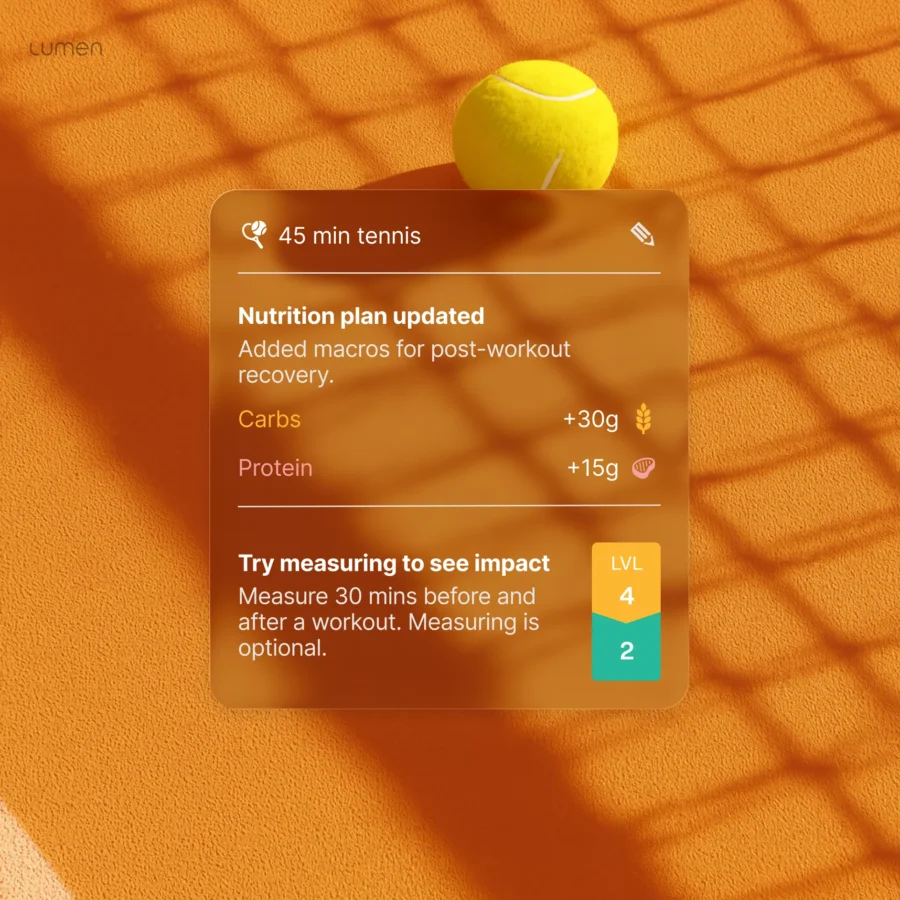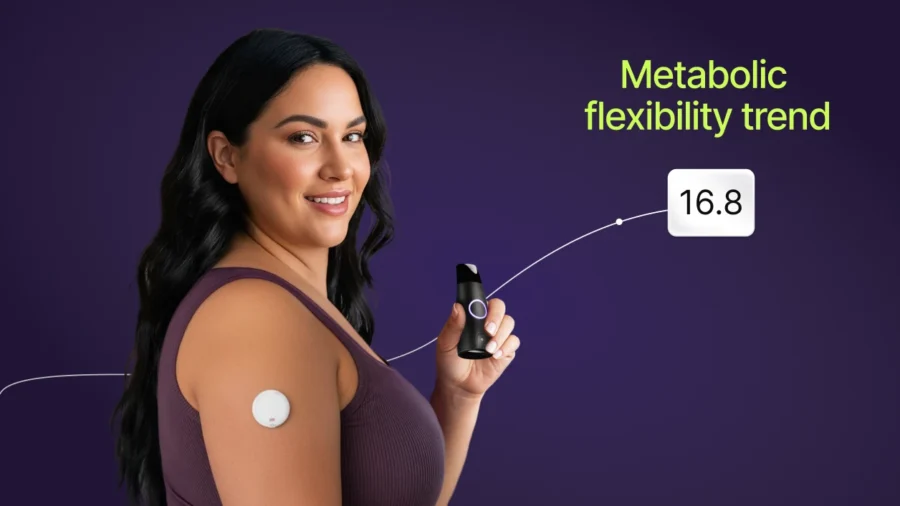Metabolic cart vs. Lumen: What’s the difference?

Measuring metabolism isn’t new. For decades, elite athletes, researchers, and healthcare professionals have relied on metabolic analysis to optimize performance, guide nutrition, and better understand the body’s energy systems. But recent advancements have made this process more accessible to everyday users, especially with the emergence of user-friendly metabolic trackers like Lumen.
So how does Lumen compare to the traditional metabolic cart method used in clinical labs and sports science centers? We’ll be breaking down the science, technology, and practicality behind each method, and everything else you may want to know.
Why measure metabolism?
SYour metabolism plays a central role in how your body produces and uses energy [1]. By understanding whether you’re primarily burning fat or carbohydrates at any given time, you can tailor your nutrition, training, and recovery to better support your health or performance goals.
For athletes, metabolic data can reveal how efficiently the body uses different fuel sources during exercise [2]. For individuals focused on fat loss, energy balance, or metabolic health, it provides insights into how well the body adapts to different dietary or fasting conditions.
Whether you’re aiming to optimize endurance, improve metabolic flexibility, or simply feel more energized throughout the day, measuring your metabolism gives you the knowledge to make smarter, more personalized decisions.Traditionally, this kind of insight has only been available through lab-based metabolic carts, which measure your breath to determine fuel usage. But now, with portable tools like Lumen, it’s possible to access real-time metabolic feedback without the need for a lab visit [3].

How is metabolism measured? Direct vs. indirect calorimetry
To understand the science behind tools like metabolic carts and Lumen’s metabolic tracker, let’s discuss some of the primary measurements used for metabolic analysis.
Direct calorimetry
Direct calorimetry assesses your metabolism by measuring the heat produced by the body. Taking this measurement requires the person to remain in a specially designed chamber called a calorimeter, where even the slightest temperature change is tracked to calculate total energy expenditure [4].
While it’s highly accurate, direct calorimetry has some drawbacks:
- It’s impractical for everyday use
- It’s expensive to run
- It’s limited to specialized research facilities
More importantly, it doesn’t provide insight into which fuel, fat or carbohydrates, the body is using. That’s where indirect calorimetry comes in.
Indirect calorimetry
Indirect calorimetry is the most widely used and practical method for metabolic analysis today. Instead of measuring heat, it estimates energy expenditure by tracking gas exchange through oxygen consumed (VO2) and carbon dioxide produced (VCO2) to calculate the respiratory exchange ratio (RER) [5].
This method is highly informative and widely used in both clinical and performance settings to assess resting metabolic rate (RMR), fuel usage, and metabolic flexibility.

Methods of indirect calorimetry
There are several lab-grade systems that perform indirect calorimetry [5], including:
- Metabolic carts: Often used in sports science and clinical labs for precise analysis. It is based on a breath-by-breath analyzer, a sensor system that measures O2 and CO2 in every breath.
- Douglas bag systems: Collect exhaled air in bags for analysis, a manual and time-intensive process used mostly in research.
- Ventilated hood systems: Often used to measure resting metabolic rate in clinical settings. The individual lies under a transparent hood while gases are analyzed.
- Lumen: A handheld metabolic tracker that measures real-time metabolic fuel usage through CO2% in one breath.
What is the respiratory exchange ratio (RER)?
RER is the volume of CO2 exhaled divided by the volume of O2 inhaled. It serves as a proxy for which fuel source your body is burning:
- Lower RER (~0.7): Indicates higher fat oxidation
- Higher RER (~1.0): Indicates higher carbohydrate oxidation
Metabolic carts measure RER through breath-by-breath analysis during rest or exercise [8]. This allows precise metabolic tracking but usually requires a lab visit, mouthpiece, and technician oversight.
What is the respiratory quotient (RQ)?
The respiratory quotient (RQ) is the ratio of CO2 produced to O2 consumed at the cellular level, not breath level.
In other words, RQ tells you what’s happening inside your cells, but we can’t measure that directly in a normal person with tools like the metabolic cart, Douglas bag, or ventilated hood.
Instead, RQ is estimated from RER measurments. During steady conditions, it’s essentially the same thing.
- An RQ of ~0.7 indicates fat is the dominant fuel.
- An RQ of ~1.0 indicates carbohydrates are the primary fuel.
While the metabolic cart, Douglas bag, and ventilated hood systems offer exceptional accuracy, they also come with limitations: they’re time-consuming, have a high cost and complex setup, and require trained personnel. They are often restricted to lab environments, which makes them less accessible.
What is the metabolic cart? A closer look
A metabolic cart is a clinical or research-grade device that measures how your body uses oxygen (O2) and produces carbon dioxide (CO2) while breathing.
From these gas exchange measurements, it calculates:
- Energy expenditure (calories burned)
- Substrate utilization: how much of that energy comes from carbohydrates vs fats
How the metabolic cart works
You breathe into a mask or mouthpiece connected to the cart. The system continuously measures:
- O2 concentration in exhaled air
- CO2 concentration in exhaled air
- Ventilation rate (how much air you breathe per minute)
Using these, it calculates:
- VO2: volume of oxygen consumed
- VCO2: volume of carbon dioxide produced
- RER: VCO2 / VO2
- Caloric expenditure via well-established equations
What are the primary uses of the metabolic cart?
Sports/performance
Measure VO2max (aerobic capacity), determine training zones, assess substrate use (fat vs carb) during exercise, optimize fueling and recovery strategies.
Clinical/medical
Assess resting metabolic rate (RMR), detect metabolic disorders, guide nutrition for patients (e.g., ICU or obesity treatment).
Research
Study metabolism, exercise physiology, energy balance, thermogenesis, etc.
How do fitness coaches and athletes use the metabolic cart?
- Measure VO2max, the gold-standard indicator of aerobic fitness.
- Determine lactate/threshold zones to personalize endurance training intensities.
- Assess fuel utilization: how much fat vs carb is burned at different intensities, informing:
- Fat-adaptation training
- Race nutrition planning
- Recovery strategies
- Track adaptations over time, monitoring improvements in efficiency or aerobic power.
- Estimate energy expenditure for precision nutrition and body composition goals.
Lactate threshold vs. FatMax: What’s the difference?
FatMax refers to the point during exercise when your body is burning fat at the highest possible rate. This is especially important for endurance athletes like marathoners, triathletes, and cyclists. A high FatMax allows the body to rely more on fat for energy and conserve glycogen (carbohydrate stores), which helps delay fatigue and maintain performance during long events. Once glycogen is depleted, the body tires quickly, so improving fat adaptation can offer a serious edge in competition [6].
Lactate threshold, on the other hand, marks the intensity at which lactate starts to accumulate in the blood, signaling a shift toward anaerobic metabolism and propensity for carb burning. This threshold helps define the upper limit of sustainable effort and is often used to guide interval training and race pacing [7].
Although FatMax and lactate threshold measure different physiological responses, both are crucial markers for endurance performance and are often tested together in sports science labs.
Lumen is currently collaborating with the University of the Sunshine Coast (UniSC) on a research study exploring how its technology can assess metabolic flexibility and FatMax during low-intensity exercise in both trained and untrained individuals. This study is running through early 2025, and aims to expand how Lumen is used in sport science and performance optimization.

Lumen: A new era of metabolic tracking
Lumen brings cutting-edge metabolic science out of the lab and into your hands and has been validated to be on par with the gold standard for metabolic measurements.
With just one breath, it measures the CO2 you exhale to reveal whether your body is burning fat or carbs. Higher CO2 means your body is burning more carbohydrates. Lower CO2 means your body is burning more fat.
The Lumen method builds on a standardized single-breath holding technique first developed by Marie Krogh in the 1960s and widely recognized in respiratory physiology for assessing gas exchange. The process is simple: You inhale to about 90% of your total lung capacity, hold your breath for ten seconds, and then exhale. At the end of the exhalation, the CO2 concentration is measured. This reflects metabolic changes, as your mitochondria, the powerhouses of your cells, regularly switch between fuel sources to best support your daily activities and metabolic flexibility.
Compared to traditional lab testing, the Lumen device offers a portable, hassle-free alternative, with no blood draws, bulky equipment, or technicians required. Lumen has over 300,000 users worldwide and is included in 100 weight loss programs at obesity clinics across the US.
With real-time metabolic insights, Lumen users can make informed decisions about their nutrition, fasting, and training anytime, anyplace.
- When you take a wake-up breath measurement, it sets the pace for the day, creates a personalized nutrition plan, and lets you know if your lifestyle is balanced.
- The bedtime breath and Overnight Fasting Tracker are two Lumen features we recommend using together with the wake-up breath to see if your body shifts from burning carbs to fats while sleeping. The goal is to wake up in fat burn, a sign of metabolic health, and spend more time fasting while sleeping than fasting endlessly during the day.
- The Lumen fasting breath determines how long you should fast, depending on whether you’re burning carbs or fats for energy. It helps prevent over-fasting and muscle breakdown by alerting you to your fasting sweet spot.
- The pre-workout breath identifies whether you should fuel up before a workout or not to avoid muscle breakdown. The post-workout breath is a barometer for how intense your exercise was and how you’re recovering.
- Through customized macros based on your metabolic measurements, AI-powered meal plans, AI health coaching, metabolic insights, and lifestyle strategies, the Lumen app always guides you to boost your Flex Score, a gauge of your metabolic flexibility.
Lumen vs. metabolic cart: key differences
Here’s a look at the differences between using a traditional metabolic cart or the Lumen device to measure your metabolism.

How Lumen proves its accuracy and reliability
Lumen has collaborated with dozens of leading universities and hospitals worldwide and published ten peer-reviewed studies exploring various aspects of metabolism and metabolic health.
To match the precision of lab-grade metabolic carts, Lumen has undergone rigorous validation through both independent academic studies and internal testing.
1. San Francisco State University validation study
This peer-reviewed study conducted at San Francisco State University compared Lumen’s measurements with the gold-standard metabolic cart by analyzing the respiratory exchange ratio (RER) and CO₂ levels. The results showed that Lumen’s readings are in agreement with the gold standard metabolic cart, validating its accuracy for assessing metabolic fuel usage [3].
2. Anglia Ruskin University (ARU) validation study
Conducted at ARU in Cambridge, this study tested Lumen’s ability to detect changes in metabolic fuel in response to high and low-carb diets in the real world. The findings validated Lumen’s ability to measure dietary changes accurately. In the study, Lumen revealed significant differences in breath CO2 levels between low-carb and high-carb lifestyles, demonstrating its capability to detect metabolic responses [8].
Read the study

The future of metabolic analysis
Lumen fills the gap between precision metabolic measurements and practicality and offers a scalable solution for:
- Daily metabolic tracking
- Nutrition customization
- Personalized fasting
- Tailored lifestyle recommendations
- Improving metabolic health
By simply measuring your breath, Lumen gives you real-time insights into whether you’re burning fats or carbs, helping you make smarter decisions about nutrition, workouts, and recovery. Regardless of whether you’re working toward a performance goal, longevity, managing your weight while on GLP-1s, supporting menopause symptoms, or just looking to feel more energized throughout the day, knowing how your body uses fuel is key.
With a growing body of scientific validation behind it, Lumen is redefining what a metabolic tracker can do. While metabolic carts still have their place, Lumen proves that accurate, high-quality data doesn’t have to be expensive, time-consuming, or out of reach.
Take control of your metabolism and start making data-driven decisions that move you closer to your goals. Get started with Lumen today.
Sources
- Sánchez López de Nava A, Raja A. Physiology, Metabolism. [Updated 2022 Sep 12]. In: StatPearls [Internet]. Treasure Island (FL): StatPearls Publishing; 2025 Jan-. Available from: https://www.ncbi.nlm.nih.gov/books/NBK546690/
- San-Millán, I., & Brooks, G. A. (2018). Assessment of Metabolic Flexibility by Means of Measuring Blood Lactate, Fat, and Carbohydrate Oxidation Responses to Exercise in Professional Endurance Athletes and Less-Fit Individuals. Sports medicine (Auckland, N.Z.), 48(2), 467–479. https://doi.org/10.1007/s40279-017-0751-x
- Lorenz, K. A., Yeshurun, S., Aziz, R., Ortiz-Delatorre, J., Bagley, J. R., Mor, M., & Kern, M. (2021). A handheld metabolic device (Lumen) to measure fuel utilization in healthy young adults: Device validation study. Interactive Journal of Medical Research, 10(2), e25371. https://doi.org/10.2196/25371
- Kenny, G. P., Notley, S. R., & Gagnon, D. (2017). Direct calorimetry: a brief historical review of its use in the study of human metabolism and thermoregulation. European journal of applied physiology, 117(9), 1765–1785. https://doi.org/10.1007/s00421-017-3670-5
- Delsoglio, M., Achamrah, N., Berger, M. M., & Pichard, C. (2019). Indirect Calorimetry in Clinical Practice. Journal of clinical medicine, 8(9), 1387. https://doi.org/10.3390/jcm8091387
- Jeukendrup, A., & Achten, J. (2001). Fatmax: A new concept to optimize fat oxidation during exercise? European Journal of Sport Science, 1(1), Article e00071507. https://doi.org/10.1080/17461390100071507
- Subbarayalu, A. V., Sivakumar, C., Purushothaman, V. K., Muralidharan, C., Krishnan Vasanthi, R., Kannan, K., Mani, P., Prabaharan, S., Ameer, M., & Kumar, U. (2024). Lactate threshold training to improve long-distance running performance: A narrative review. Montenegrin Journal of Sports Science and Medicine, 20(1), 3–13. https://doi.org/10.26773/mjssm.240303
- Roberts, J., Dugdale-Duwell, D., Lillis, J., Pinto, J. M., Willmott, A., Yeshurun, S., … Souren, T. (2023). The efficacy of a home-use metabolic device (Lumen) in response to a short-term low and high carbohydrate diet in healthy volunteers. Journal of the International Society of Sports Nutrition, 20(1). https://doi.org/10.1080/15502783.2023.2185537







 Digital download
Digital download 


